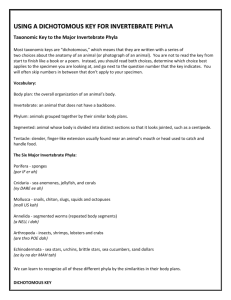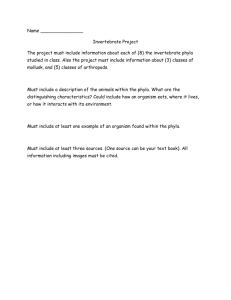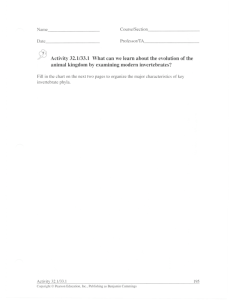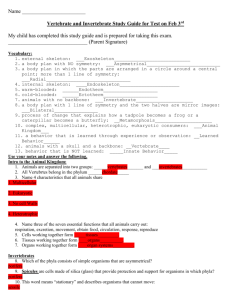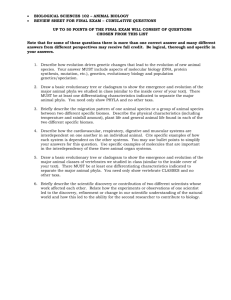Invertebrates Test Review Sheet - High School Biology
advertisement
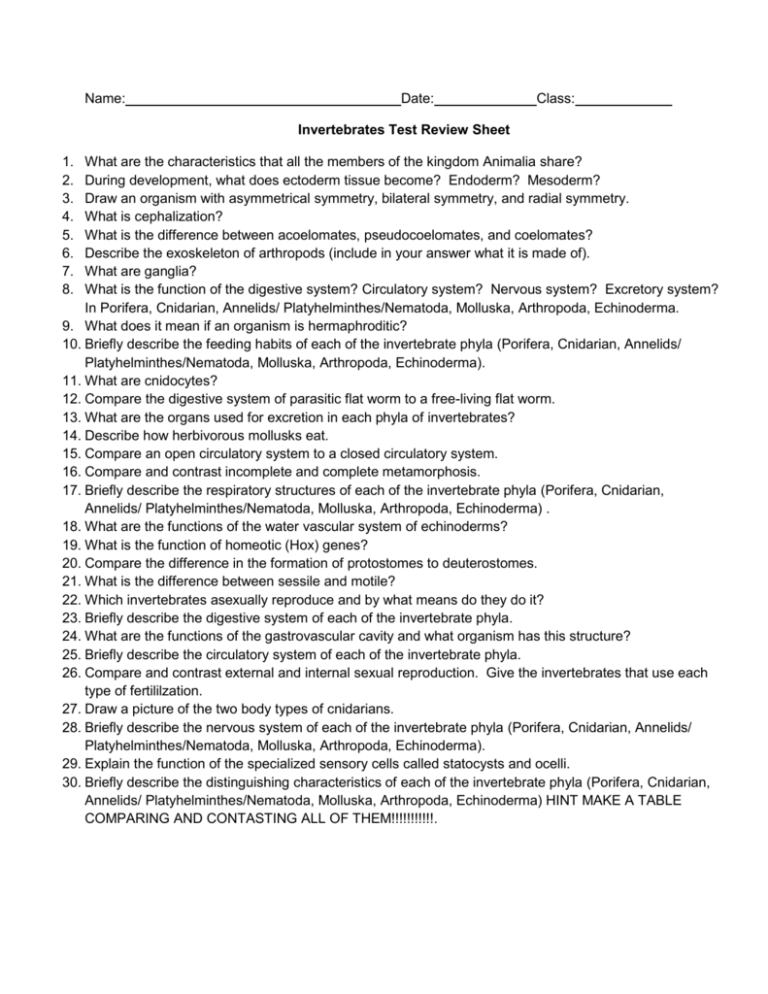
Name: Date: Class: Invertebrates Test Review Sheet 1. 2. 3. 4. 5. 6. 7. 8. What are the characteristics that all the members of the kingdom Animalia share? During development, what does ectoderm tissue become? Endoderm? Mesoderm? Draw an organism with asymmetrical symmetry, bilateral symmetry, and radial symmetry. What is cephalization? What is the difference between acoelomates, pseudocoelomates, and coelomates? Describe the exoskeleton of arthropods (include in your answer what it is made of). What are ganglia? What is the function of the digestive system? Circulatory system? Nervous system? Excretory system? In Porifera, Cnidarian, Annelids/ Platyhelminthes/Nematoda, Molluska, Arthropoda, Echinoderma. 9. What does it mean if an organism is hermaphroditic? 10. Briefly describe the feeding habits of each of the invertebrate phyla (Porifera, Cnidarian, Annelids/ Platyhelminthes/Nematoda, Molluska, Arthropoda, Echinoderma). 11. What are cnidocytes? 12. Compare the digestive system of parasitic flat worm to a free-living flat worm. 13. What are the organs used for excretion in each phyla of invertebrates? 14. Describe how herbivorous mollusks eat. 15. Compare an open circulatory system to a closed circulatory system. 16. Compare and contrast incomplete and complete metamorphosis. 17. Briefly describe the respiratory structures of each of the invertebrate phyla (Porifera, Cnidarian, Annelids/ Platyhelminthes/Nematoda, Molluska, Arthropoda, Echinoderma) . 18. What are the functions of the water vascular system of echinoderms? 19. What is the function of homeotic (Hox) genes? 20. Compare the difference in the formation of protostomes to deuterostomes. 21. What is the difference between sessile and motile? 22. Which invertebrates asexually reproduce and by what means do they do it? 23. Briefly describe the digestive system of each of the invertebrate phyla. 24. What are the functions of the gastrovascular cavity and what organism has this structure? 25. Briefly describe the circulatory system of each of the invertebrate phyla. 26. Compare and contrast external and internal sexual reproduction. Give the invertebrates that use each type of fertililzation. 27. Draw a picture of the two body types of cnidarians. 28. Briefly describe the nervous system of each of the invertebrate phyla (Porifera, Cnidarian, Annelids/ Platyhelminthes/Nematoda, Molluska, Arthropoda, Echinoderma). 29. Explain the function of the specialized sensory cells called statocysts and ocelli. 30. Briefly describe the distinguishing characteristics of each of the invertebrate phyla (Porifera, Cnidarian, Annelids/ Platyhelminthes/Nematoda, Molluska, Arthropoda, Echinoderma) HINT MAKE A TABLE COMPARING AND CONTASTING ALL OF THEM!!!!!!!!!!!.
